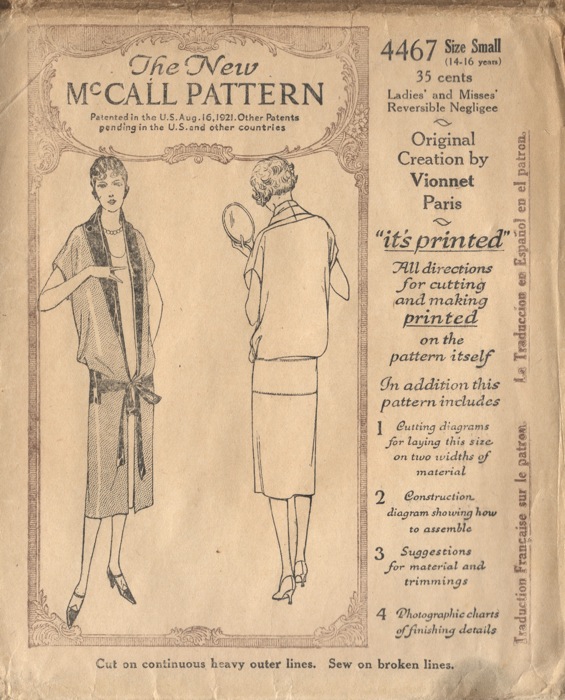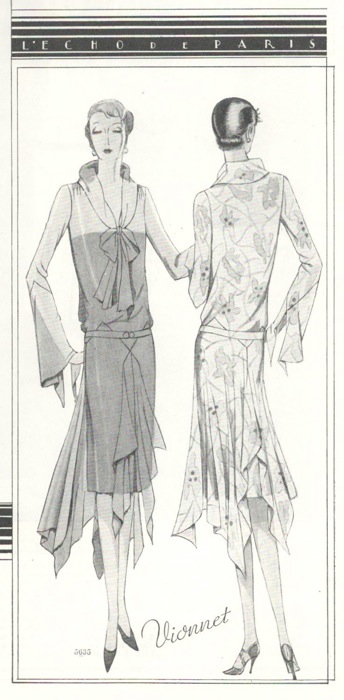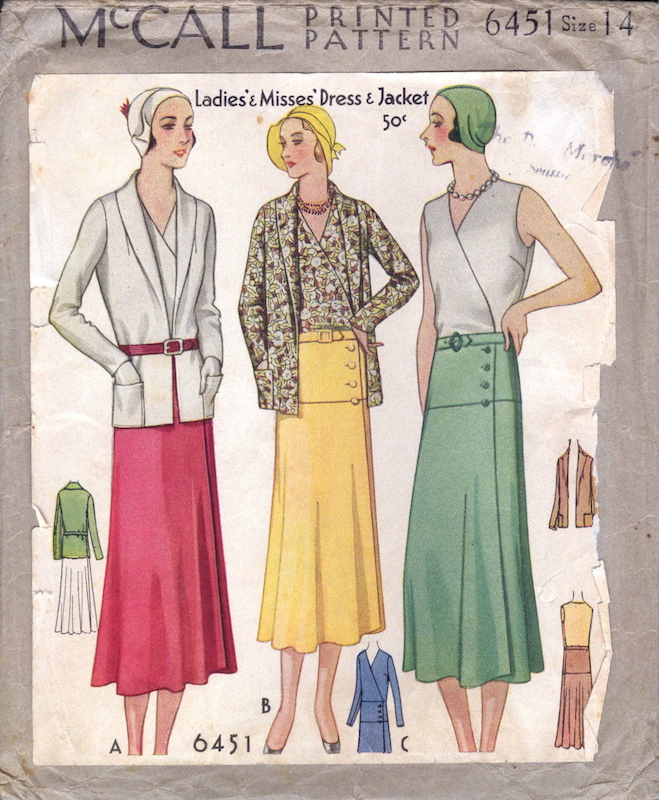
The reputation of Madeleine Vionnet (1876-1975), the brilliant innovator in draping and the bias cut, has only increased with time. The label she founded in 1912 was recently revived, and Betty Kirke’s book is back in print for the house’s 100th anniversary. You can see Vionnet pieces online at the V&A and the Costume Institute. There’s even an animated video on Vimeo demonstrating the construction of one Vionnet dress. (For more on Vionnet, see Lisa’s Coletterie post; Betty Kirke’s 1989 Threads article; and Sandra Ericson’s revised 2010 Threads article, in pdf here.)

In recent years, those who wished to reproduce a Vionnet design could trace their pattern from a book. Janet Arnold’s Patterns of Fashion 2: Englishwomen’s Dresses and their Construction, c. 1860-1940 (Macmillan, 1982) includes five Vionnet patterns, and the Japanese companion volume to Kirke’s book (Bunka Fashion College, 2002; available on amazon.co.jp) contains tested, traceable versions of twenty-eight of Kirke’s Vionnet patterns. Costumer Koshka has made the 1919 Vionnet dress in Patterns of Fashion, while the Vionnet Identique project saw all the designs in Kirke’s book made up in half-scale for an exhibition and book (for photos see this Threads post and the book preview).

In the 1920s and 1930s, dressmakers could sew Vionnet designs using commercial patterns. McCall’s released patterns based on Vionnet originals, while companies like Pictorial Review sold adaptations of Vionnet designs. Here is a selection of Vionnet patterns.
These two patterns for a negligee and day dress date to 1926. The negligee is reversible:


Vionnet was known for her robes à mouchoirs, or handkerchief dresses, like this evening dress:

This formal dress is another handkerchief dress. Note the triangular sleeve insets:

Here’s a magazine illustration of McCall 5635 from the following year. The accompanying text reads, “A Vionnet gown characteristic of the graceful new formal frocks is simply made to fall in points at the center front and at the sides and back”:

Both McCall’s and Pictorial Review released patterns for this circa 1931 ensemble:


McCall’s magazine showed two illustrations for this design (McCall 6451); the text on the first page reads, “A masterpiece in simplicity that only Vionnet could have created. The chic contrasting bodice top is sleeveless and joins the skirt in a coat-dress closing”:


The ensemble was also illustrated on the cover of McCall Style News shown at the top of this post. Here’s the full illustration:

This 1932 Pictorial Review design for an asymmetrical day dress was adapted from Vionnet. The skirt and applied front are cut on the bias:

Here’s the corresponding illustration in Pictorial Review magazine. The accompanying text reads, “Yes, it’s a Vionnet, we knew you would recognize it in the characteristic handling of the diagonal seaming, in the clever use of button trimming, and in its absolute simplicity. Make it in a sheer linen with contrasting button accents”:

Finally, a three-piece suit pattern from the same year, consisting of a short-sleeved blouse, high-waisted suspender skirt, and jacket that criss-crosses in the front:

This illustration for McCall 6999 accompanies a trend report on suits:

And if you’d like to try your hand at some Vionnet-style fabric embellishment, the Center for Pattern Design sells a pattern for Vionnet roses.
Madeleine Vionnet is said to have considered herself a “geometrician”; the brilliance of her technique reveals itself in her garments’ construction. Have you tried making any Vionnet designs?
an absolutely fascinating post. the images are so gorgeous- makes me want to try a pattern (although 21st century self would hardly fit the 1920s ideal.) and great commentary – unpacking the ideals behind the images…thanks!
I haven’t sewn any vionnet design yet, but I made a paper mock up of her spiral dress – it’s amazing! I am glad to know Kirke’s book is back on print. Thanks for the wonderful post!
Sweet, thanks for all the link-you’ve obviously compiled a lot of research effort here-on an aside, the Japanese book doesn’t have traceable patterns-they’re grided i.e. you have to enlarge them manually/ by scanning and vectorisation.
That diagonally seamed dress is making my mouth water!
thank you as always for an informative and inspirational post. i just scoured the internets for a copy; in addition to amazon.co.jp, it is available through etsy seller pomadour24 (as of this comment, 14 dec 2012).
Awesome, thanks for this, Devra! It’s going on my wishlist..
wow, stunning illustrations and designs! it’s nice to know the back-story on this amazing designer, whose images i’ve always admired.
Thank you so much for this post- so inspiring!
Your illuminating presentation of Mme. Vionnet’s work is wonderfully well done. Thank you. As always, your research is thorough, organized and interesting.
This was fascinating, I learned so much!
Thanks for gathering all this together and sharing.
Wow, thanks, everyone! I’m so glad you enjoyed my research-in-progress.
I really love the last look pictured… the one on the right.
Great research, thank you so much. And here http://pinterest.com/pin/381328293418916748/ you’ll find another Vionnet-inspired frock which is Pictorial Review 5627
Glad you enjoyed it! Thanks for the link. Your Pinterest looks a lot like my iPhoto 🙂
totally and utterly fabulous
Such an informative article, thank you for sharing.